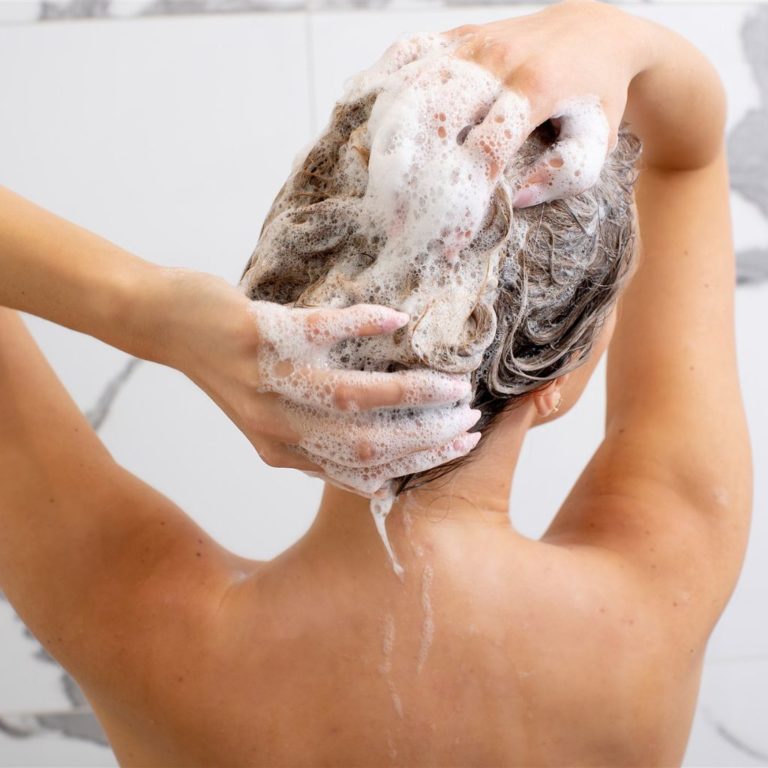10 reasons that are causing hair loss
From a scientific point of view, there are various factors that can lead to hair loss. let’s take a look at them together.
- Genetics
A family history of hair loss increases the risk of baldness. When hair loss is caused by your genetics, it occurs in a predictable pattern often referred to as male pattern baldness (MPB) or female pattern baldness (FPB).
Hair loss can range from mild hair thinning to total baldness. Hair can fall out for many different reasons. Medically, hair loss falls into several categories that you can find below.
- Unhealthy scalp
Unhealthy scalp conditions as dry flaky scalp or dandruff can cause hair loss. It is one of the most important things to take care of your scalp when you want to grow healthy hair or stop hair loss. New Hair Goal hair growth shampoo is designed to keep your scalp clean and healthy while stimulating hair growth. Using hair growth shampoo and treatment ampules together you can achieve the best results possible to deliver the best nutrients and antioxidants that your hair needs.
- Telogen Effluvium
This common form of hair loss happens two to three months after a major body stress, such as a prolonged illness, major surgery or serious infection. It can also happen after a sudden change in hormone levels, especially in women after childbirth. You can notice the moderate amount of hair fall out from the scalp, on a pillow, in the tub or on a hairbrush. While hair on some parts of the scalp may appear thinner, it is rare to see large bald spots.
- Side effect of Drugs
Hair loss can be a side effect of certain medications, including lithium, beta-blockers, warfarin, heparin, amphetamines and levodopa (Atamet, Larodopa, Sinemet). In addition, many medications used in cancer chemotherapy — such as doxorubicin (Adriamycin) — commonly cause sudden hair loss affecting the entire head.
- Symptom of a medical illness
Hair loss can be one of the symptoms of a medical illness, such as systemic lupus erythematosus (lupus), syphilis, a thyroid disorder (such as hypothyroidism or hyperthyroidism), a sex-hormone imbalance or a serious nutritional problem, especially a deficiency of protein, iron, zinc or biotin. These deficiencies are most common in people on restrictive diets and women who have very heavy menstrual flow.
- Tinea Capitis (Fungal infection of the scalp)
This form of patchy hair loss happens when certain types of fungi infect the scalp. This causes the hair to break off at the scalp surface and the scalp to flake or become scaly. Tinea capitis is a common form of patchy hair loss in children.
- Alopecia Areata
This is an autoimmune disease that causes hair to fall out in one or more small patches. The cause of this condition is unknown, although it is more common in people who have other autoimmune diseases. When the same process causes total loss of hair from the scalp it is known as alopecia totalis.
- Traumatic alopecia
This form of hair loss is caused by hairdressing techniques that pull the hair (tight braiding or cornrowing), expose hair to extreme heat and twisting (curling iron or hot rollers) or damage the hair with strong chemicals (bleaching, hair coloring, permanent waves). In addition, some people have an uncommon psychiatric disorder (trichotillomania) in which compulsive hair pulling and twisting can cause bald spots.
- Hereditary pattern baldness, or androgenetic alopecia
In men, hair loss may follow the typical male pattern (receding front hairline and/or thinning hair at the top of the head). This is the most common type of hair loss, and it can begin at any time in a man’s life, even during his teen years. It usually is caused by the interaction of three factors: an inherited tendency toward baldness, male hormones and increasing age. Many women will develop some degree of female-pattern baldness. In women, thinning occurs over the entire top or crown of the scalp, sparing the front of the scalp.
- Nutritional deficiencies
A lack of specific nutrients, such as iron, protein, and vitamin D, can contribute to hair loss.
- Protein: Hair is made of a protein called keratin, so it’s important to consume enough protein in your diet. Good sources of protein include lean meats, poultry, fish, beans, lentils, tofu, and low-fat dairy products.
- Iron: Iron is an essential mineral that helps carry oxygen to the cells in your body, including those in your hair follicles. Good sources of iron include lean red meat, poultry, fish, beans, lentils, spinach, and fortified breakfast cereals.
- Zinc: Zinc is important for healthy hair growth and repair. Good sources of zinc include oysters, beef, pumpkin seeds, and fortified cereals.
- Biotin: Biotin is a B vitamin that is essential for healthy hair, skin, and nails. Good sources of biotin include eggs, nuts, whole grains, and some vegetables.
- Omega-3 fatty acids: Omega-3 fatty acids are important for overall hair health and can be found in fatty fish, flaxseed, chia seeds, and walnuts.
- Vitamin D: Vitamin D is important for hair follicle cycling and can be found in fortified dairy products, mushrooms, and sunlight.
In addition to a healthy diet, it’s important to manage stress, get enough sleep, and avoid harsh styling practices that can damage your hair. If you’re experiencing significant hair loss or thinning, it’s important to consult a healthcare provider to identify any underlying medical conditions or nutrient deficiencies that may be contributing to the problem.
REFERENCES:
Harvard Health Publishing
https://www.health.harvard.edu/a_to_z/hair-loss-a-to-z
American Academy of Dermatology
https://www.aad.org/










